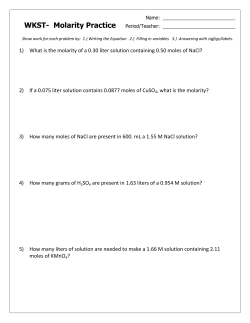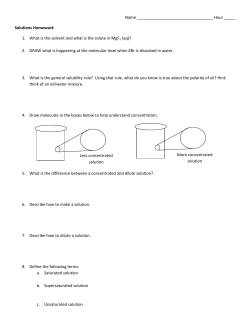
Mock Final Exam
Chemistry Final Exam Do Not Write On This Document Item 1: Sulfuric acid is a pungent and colorless mineral acid. It is often dyed dark brown during production to alert people to its hazards. It was known historically as oil of vitriol. Identify the molecular formula for sulfuric acid: A. HCl B. H2SO4 C. HNO3 D. H3PO4 Item 2: Polyprotic acids are capable of donating more than a single proton per molecule in acidbase reactions. Protons are lost through several stages, with the first proton being the fastest and most easily lost. Identify the polyprotic acid below. A. H3PO4 B. HCl C. HBr D. HClO3 Item 3: As determined by the percent disassociation in water, which of the following acids can be classified as a strong acid? A. an acid with 100% disassociation B. an acid with 99% disassociation C. an acid with 98% disassociation D. All of the above Item 4: If the pOH of an unknown solution is 9.5 what is the solution’s pH? A. 3.5 B. 4.5 C. 5.5 D. 6.5 Item 5: -3 A solution has a hydrogen ion concentration [H+] of 1.0 × 10 molar. What is the pH of the solution? A. 0.1 B. 1.0 C. 0.3 D. 3.0 Item 6: A NH3 solution in water has a hydronium ion (H3O+) concentration of -9 2.53 × 10 molar. What is the pH of the NH3 solution? A. 8.60 B. 9.20 C. 10.60 D. 11.50 Item 7: A solution of H3PO4 in water has a hydronium ion (H3O+) concentration of -2 7.90 × 10 molar. What is the pH of the H3PO4 solution? A. 4.50 B. 3.10 C. 2.20 D. 1.10 Item 8: An unknown compound has the empirical formula C3HO. Which of the following molecular formulas corresponds to the given empirical formula? A. C7H2O2 B. C6H3O3 C. C6HO D. C6H2O2 Item 9: A sample of a compound was found to contain 54 grams (2 moles) of aluminum, 96 grams (6 moles) of oxygen, and 6 grams (6 moles) of hydrogen. What is the empirical formula of this compound? A. Al6OH B. AlO3H3 C. Al3O3H3 D. Al2O6H6 Item 10: The Brønsted–Lowry definition of acids and bases was proposed independently by Johannes Nicolaus Brønsted and Thomas Martin Lowry in 1923. According to this definition of acids and bases, all acids are capable of: A. accepting hydrogen (H+) atoms. B. donating hydrogen (H+) atoms. C. increasing the hydroxide (OH-) component of a water solution. D. releasing hydroxide (OH-) ions into a water solution. Item 11: Use a periodic table to determine how many grams are in two moles of glucose (C6H12O6). A. 90 grams B. 180 grams C. 360 grams D. 400 grams Item 12: Use the reaction equation to answer the question. CH4(g) + 2O2(g) CO2(g) + 2H2O(g) The equation shows methane gas (CH4) burning in oxygen (O2). If 64 grams (4 moles) of methane are burned, how many grams of carbon dioxide (CO2) are produced? A. 44 grams B. 56 grams C. 132 grams D. 176 grams Item 13: Use the reaction equation to answer the question. PCl3 + _?_H2O H3PO3 + 3HCl The equation shows a reaction between phosphorus tri-chloride (PCl3) and water (H2O). How many moles of water (H2O) are needed to balance the equation? A. 1 mole B. 2 moles C. 3 moles D. 6 moles Item 14: According to the Law of Conservation of Mass, what happens to the atoms in a chemical reaction? A. The atoms are rearranged with no loss in mass. B. Some atoms are destroyed, resulting in mass being converted to energy. C. There is a small gain in mass as new atomic bonds are formed. D. The atoms remain unchanged with no change in mass. Item 15: The diagram shows the structural formula for 2-methyl-1-propene. Which property allows this molecule to be classified as an alkene? A. It has an even number of carbon atoms. B. It includes methyl groups attached to carbon atoms. C. It has a double bond between carbon atoms. D. It is a symmetrical molecule. Item 16: Which structural formula represents n-hexane (straight chain hexane)? A. B. C. D. Item 17: Which of the following chemical reactions is correctly balanced? A. MgO Mg + O2 B. 2MgO Mg + O2 C. 2MgO 2Mg + O2 D. 3MgO 3Mg + O2 Item 18: Which of the following chemical reactions is correctly balanced? A. 3HCl + NaOH 3H2O + NaCl B. 2HCl + 2NaOH H2O + NaCl C. HCl + NaOH 2H2O + NaCl D. HCl + NaOH H2O + NaCl Item 19: Use the model to answer the question. What is the name of the compound represented by this model? A. n-hexane B. 2-methyl-butane C. 2-ethyl-pentane D. 3-methyl-butane Item 20: Using Lavoisier’s Law of Conservation of Mass, determine how many grams of O 2 would be created if 80.6 grams of MgO is decomposed as in the following reaction: 2MgO 80.6 grams A. 28.0 grams 2Mg + O2 48.6 grams B. 32.0 grams C. 48.0 grams D. 48.6 grams Item 21: Identify the type of chemical reaction represented by the following reaction formula: HBr + NaOH NaBr + H2O A. a decomposition B. an acid-base reaction C. a single-displacement reaction D. a combustion reaction Item 22: Identify the type of chemical reaction represented by the following reaction formula: 2C2H2 + 5O2 4CO2 + 2H2O A. a decomposition B. an acid-base reaction C. a single-displacement reaction D. a combustion reaction Item 23: Identify the type of chemical reaction represented by the following reaction formula: C10H8 + 12O2 10CO2 + 4H2O A. a decomposition B. an acid-base reaction C. a single-displacement reaction D. a combustion reaction Item 24: Identify the type of chemical reaction represented by the following reaction formula: 2H2O 2H2 + O2 A. a decomposition B. an acid-base reaction C. a double-displacement reaction D. a combustion reaction Item 25: Identify the type of chemical reaction represented by the following reaction formula: Fe + Cu(NO3)2 Fe(NO3)2 + Cu A. a decomposition B. an acid-base reaction C. a single-displacement reaction D. a combustion reaction Item 26: Avogadro's number is the number of particles found in one mole of a substance and its value is: A. 6.023 x 1022 B. 6.022 x 1023 C. 6.02 x 1022 D. 6.02 x 1023 Item 27: Which of the following molecules is best classified as an aldehyde? A. B. C. D. Item 28: Which of the following molecules is best classified as an alcohol? A. B. C. D. Item 29: Which of the following molecules is best classified as an amine? A. B. C. D. Item 30: Based on the given rules of solubility, which of the following compounds is insoluble? A. sodium carbonate B. magnesium sulfate C. magnesium carbonate D. sodium hydroxide Item 31: Based on the given rules of solubility, which of the equations below shows a precipitate that is actually soluble in water? A. 2NaCl(aq) + Ca(OH)2(aq) 2NaOH(s) + CaCl2(aq) B. BaCl2(aq) + Na2SO4(aq) BaSO4(s) + 2NaCl(aq) C. MgSO4 + Na2CO3 MgCO3(s) + Na2SO4(aq) D. 3KCl(aq) + (NH4)3PO4(aq) K3PO4(s) + 3NH4Cl(aq) Item 32: Herbert prepared the table in order to classify different hydrocarbons according to their structure. Which list correctly classifies these hydrocarbons? A. 1 – alkyne; 2 – alkane; 3 – alkene; 4 – alkane B. 1 – alkene; 2 – alkane; 3 – alkane; 4 – alkyne C. 1 – alkane; 2 – alkene; 3 – alkyne; 4 – alkene D. 1 – alkene; 2 – alkyne; 3 – alkane; 4 – alkyne Item 33: The Haber process, also called the Haber–Bosch process, is the industrial procedure most often used to produce ammonia. Atmospheric nitrogen is nutritionally unavailable to plants and must therefore be converted into a form, such as ammonia, that can be used as fertilizer. Identify the Haber process below: A. HCl + NaOH NaCl + H2O B. 2MgO 2Mg + O2 C. N2 + 3H2 2NH3 D. CH4 + 2O2 CO2 + 2H2O Item 34: Le Châtelier's principle states that, “When a system at equilibrium is subjected to change in concentration, temperature, volume, or pressure, then the system readjusts itself to counteract the effect of the change and a new equilibrium is established.” This important principle is used by chemists to: A. Increase or decrease the amounts of the products during an equilibrium reaction. B. Prevent products from forming during an equilibrium reaction. C. Create catalysts that will be consumed during other chemical reactions. D. Predict the outcome of a non-equilibrium reaction. Item 35: What is the percent yield for a chemical reaction in which the theoretical yield of hydrogen cyanide (HCN) is 140 grams, but the actual yield is 105 grams? A. 90.1% B. 82.1% C. 80.0% D. 75.0% Item 36: Determine the theoretical yield of CO2 in the following reaction: 2C2H2 + 5O2 4CO2 + 2H2O A. 44 grams B. 88 grams C. 132 grams D. 176 grams Item 37: Determine the percent yield for H2O if 27 grams of water is produced in the following reaction: 2C2H2 + 5O2 4CO2 + 2H2O A. 65.0% B. 75.0% C. 80.0% D. 85.0% Item 38: Determine the number of moles in the 27 grams of water (H2O) produced in the previous reaction: A. 1.0 moles B. 1.5 moles C. 1.7 moles D. 2.1 moles Item 39: Determine the percent yield if 30 grams of ammonia (NH3) are produced in the following reaction: N2 + 3H2 2NH3 A. 75.6% B. 79.6% C. 80.2% D. 88.2% Item 40: Determine the number of moles in the 30 grams of ammonia (NH3) produced in the previous reaction: A. 0.1 moles B. 0.8 moles C. 1.0 moles D. 1.8 moles
© Copyright 2025









